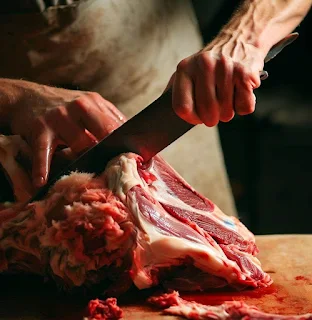First Timers Guide to Mastering the Art of Skop, Making a Sheep's Head Stew
As a chef, I encourage you to try the unique culinary experience of cooking a Skop, or sheep's head stew. While the idea of cooking the head of an animal might seem unfamiliar or unusual, it's important to approach it with an open mind and appreciate the cultural significance and flavors it offers.
The Skop stew captures the essence of traditional Zimbabwean cuisine, showcasing the rich and slightly gamey flavors of the tender meat around the cheeks and jowls. The gelatinous broth that forms during the slow cooking process adds a luxurious texture and enhances the overall richness of the dish.
I understand that cooking a sheep's head may involve some initial work, such as cleaning, skinning, and trimming excess fat or tissue. However, online tutorials and guidance from a butcher can provide step-by-step instructions to make the process more approachable and manageable.
Remember, exploring new tastes and textures is what makes cooking an exciting adventure. By embracing the experience and delving into cultural traditions, you'll discover a dish that is not only delicious but also represents the culinary heritage of Zimbabwe.
So, don't be put off by the idea of cooking a sheep's head. Instead, I invite you to embrace this culinary journey and try the Skop recipe. You'll be rewarded with a flavorful and memorable dish that celebrates the rich culinary tapestry of Zimbabwe.
If you're making the sheep head stew recipe for the first time, there are a few things you should anticipate when it comes to preparation, flavor, and texture.
When preparing a sheep's head, it's important to thoroughly clean it. Start by rinsing the head under running water to remove any loose dirt or debris. Use a brush or scrubbing pad to scrub the head, paying attention to crevices and hard-to-reach areas. Ensure that all fur remnants are removed.
Skinning the sheep's head involves removing the tough outer layer of skin. You can use a sharp knife to carefully cut through the skin along the jawline, then gently peel it back to expose the meat underneath. Continue peeling the skin away from the head, working your way around the cheeks, eyes, and ears. Take care to remove any remaining hair or fur.
Once the head is skinned, you may need to trim excess fat or tissue. Sheep's head can be quite fatty, so removing some of the excess fat can help balance the flavors and prevent the stew from becoming overly greasy. Use a sharp knife to trim any visible fat or tissue, while still leaving enough to contribute to the richness of the dish.
Sheep's head offers a unique flavor profile. The meat around the cheeks and jowls is tender and succulent, with a rich and slightly gamey taste. It can be quite fatty, which contributes to the richness of the stew. The broth from stewing the head is particularly flavorful, thanks to the collagen present in the head. This collagen breaks down during the slow cooking process, resulting in a gelatinous consistency that adds richness and body to the stew.
As the sheep's head simmers in the stew, the collagen-rich connective tissues break down, releasing gelatin into the broth. This gives the stew a thicker consistency and adds a silky mouthfeel. The gelatinous broth is prized for its flavor and contributes to the overall richness and depth of the dish.
Finding a sheep's head for your recipe is easy.
If you're a visual learner and new to preparing a sheep's head, it's a good idea to refer to online tutorials or consult with a butcher for guidance. They can provide detailed instructions on cleaning, skinning, and trimming the head based on your specific needs.
Finding a sheep's head for your recipe is easy; you can find it at several places. Local butcher shops or specialty meat markets, Halal meat markets, and Ethnic grocery stores that cater to African, Middle Eastern, or Caribbean communities are the usual suspects. Additionally, online meat retailers may have sheep's head available for purchase.
In Zimbabwe, sheep head stew is known as skop. It is a traditional delicacy and is commonly the centerpiece dish of the meal. Skop is often served with sadza, a traditional Zimbabwean staple made from maize meal, and enjoyed with vegetables or relishes.
Skop Sheep's Head Stew
Ingredients
1 sheep's head, cleaned and skinned
2 onions, chopped
4 cloves of garlic, minced
2 tomatoes, chopped
2 tablespoons vegetable oil
2 tablespoons tomato paste
2 carrots, peeled and chopped
2 potatoes, peeled and chopped
2 bell peppers, chopped
2 cups beef or vegetable stock
1 teaspoon paprika
1 teaspoon ground coriander
1 teaspoon ground cumin
1 teaspoon turmeric
Salt and pepper to taste
Fresh parsley or cilantro, chopped (for garnish)
Directions
-
Thoroughly clean and skin the sheep's head. Remove any excess fur and wash it under running water. Cut the head into smaller, manageable pieces.
-
In a large pot, heat the vegetable oil over medium heat. Add the chopped onions and minced garlic, and sauté until they become translucent and fragrant.
-
Add the sheep's headpieces to the pot and brown them on all sides. This will help enhance the flavors in the stew.
-
Once the meat is browned, add the chopped tomatoes and tomato paste. Stir well to coat the meat and vegetables with the tomato paste.
-
Add the carrots, potatoes, and bell peppers to the pot. Mix everything together.
-
Pour in the beef or vegetable stock, ensuring all the ingredients are submerged. If needed, add more water to cover them.
-
Add the paprika, ground coriander, ground cumin, turmeric, salt, and pepper to the pot. Stir well to evenly distribute the spices.
-
Cover the pot and let the stew simmer over low heat for about 2 to 3 hours, or until the meat is tender and the flavors have melded together. Stir occasionally and add more water if necessary to maintain the desired consistency.
-
Once the stew is done, remove it from the heat. Serve the Skop hot, garnished with freshly chopped parsley or cilantro.
Cooking a Skop, or sheep's head stew, is a culinary adventure that takes you on a journey through Zimbabwe's cultural traditions and flavors. It is a unique opportunity to embrace the experience and immerse yourself in the process of exploring new tastes and textures. While the idea of cooking the head of an animal might seem unfamiliar or unusual, it's important to approach it with an open mind and cultural reverence.
The rich and slightly gamey flavor of the tender meat around the cheeks and jowls, combined with the gelatinous broth that forms during the slow cooking process, truly captures the essence of this traditional Zimbabwean dish. So, embrace this culinary adventure and savor the opportunity to discover the delicious flavors that Skop has to offer.








Comments
Post a Comment
Thank you for getting in touch! We appreciate you contacting us here at the African Gourmet. African food culture is world heritage, thank you! Want to read the latest African food news from the African Gourmet visit our website www.africanfood.recipes.